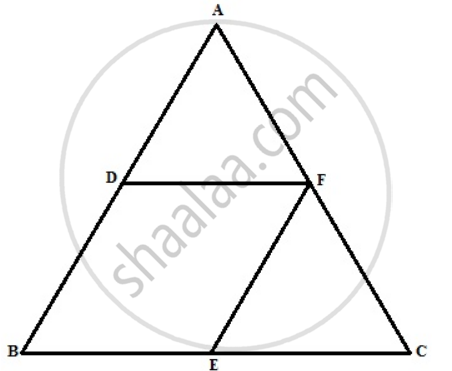Advertisements
Advertisements
प्रश्न
D and F are midpoints of sides AB and AC of a triangle ABC. A line through F and parallel to AB meets BC at point E.
- Prove that BDFE is a parallelogram
- Find AB, if EF = 4.8 cm.
उत्तर
The required figure is shown below
(i) Since F is the midpoint and EF || AB.
Therefore E is the midpoint of BC.
So, `BE = 1/2BC and EF = 1/2AB` …..(1)
Since D and F are the mid-points of AB and AC
Therefore DE || AC.
So, `DF = 1/2BC and DB = 1/2"AB"` …..(2)
From (1), (2) we get
BE = DF and BD = EF
Hence BDEF is a parallelogram.
(ii) Since
AB = 2EF
= 2 × 4.8
= 9.6 cm.
APPEARS IN
संबंधित प्रश्न
In Fig. below, BE ⊥ AC. AD is any line from A to BC intersecting BE in H. P, Q and R are
respectively the mid-points of AH, AB and BC. Prove that ∠PQR = 90°.

In Δ ABC, AD is the median and DE is parallel to BA, where E is a point in AC. Prove that BE is also a median.
In ΔABC, BE and CF are medians. P is a point on BE produced such that BE = EP and Q is a point on CF produced such that CF = FQ. Prove that: QAP is a straight line.
ΔABC is an isosceles triangle with AB = AC. D, E and F are the mid-points of BC, AB and AC respectively. Prove that the line segment AD is perpendicular to EF and is bisected by it.
The diagonals AC and BD of a quadrilateral ABCD intersect at right angles. Prove that the quadrilateral formed by joining the midpoints of quadrilateral ABCD is a rectangle.
In the given figure, T is the midpoint of QR. Side PR of ΔPQR is extended to S such that R divides PS in the ratio 2:1. TV and WR are drawn parallel to PQ. Prove that T divides SU in the ratio 2:1 and WR = `(1)/(4)"PQ"`.
The figure obtained by joining the mid-points of the sides of a rhombus, taken in order, is ______.
D and E are the mid-points of the sides AB and AC of ∆ABC and O is any point on side BC. O is joined to A. If P and Q are the mid-points of OB and OC respectively, then DEQP is ______.
E is the mid-point of a median AD of ∆ABC and BE is produced to meet AC at F. Show that AF = `1/3` AC.
Show that the quadrilateral formed by joining the mid-points of the consecutive sides of a square is also a square.
